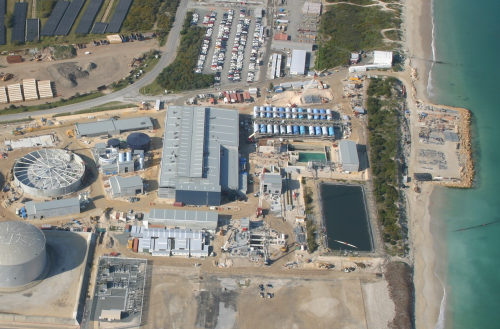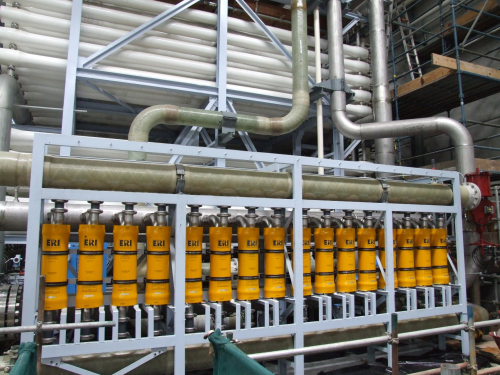

A combination of low rainfall, representing the worst drought in a century, and increasing population have had a major impact on the drinking water supplies in Western Australia in recent years, making it a priority for the Water Corporation to examine new water resources close to the large coastal communities. Stream flows into dams have reduced by an estimated two thirds in the past 30 years and the groundwater systems have been placed under stress during this period.
This situation is not just confined to Perth , as many other areas of Australia are also similarly affected. According to Gary Crisp of the Water Corporation, Gold Coast, Sydney , Adelaide , Brisbane and Gosford-Wyong are among other coastal cities that are taking a very hard look at using seawater desalination as a means of relieving their problems. The Kwinana plant on the Cockburn Sound is being regarded as being a model for sustainable seawater desalination plants.
Built at a cost of Aus$324 (US$290) million, energy efficiency and environmental impact have been given the highest levels of attention. An 80MW wind farm is the source of its energy and this makes it the world's largest desalination plant using renewable energy. With 12 SWRO trains providing a capacity of 160,000 m³/day and six BWRO trains delivery a final product of 144,000 m³/day, the plant will have one of the world's lowest specific energy consumptions due in part to the use of ERI Inc's PX Pressure Exchanger devices.
"The PX65 series is an isobaric chamber type of energy recovery device which recovers energy in the brine stream and delivers it to water going into the membrane feed," says Shawn Meyer-Steele, Vice-President marketing, Energy recovery Inc. "Having a net transfer efficiency of up to 98%, it is the world's most efficient ERD commercially available."
Shawn Meyer-Steele reports that the Water Corporation and Degremont selected ERI's PX technology for their optimised design because it offers significant benefits in the form of net energy transfer and very low lifecycle costs. He goes on the say that additional benefits include maximum design flexibility, reduced high pressure pump costs and operational flexibility.
The Perth plant incorporates two separate streams each having the capacity to produce 72,000 m³ per day of drinking water via a two-pass SWRO system. At optimum production the intake unit, which is submerged 200 m offshore in 10 m of water will gravitate 364,000 m³ per day of seawater via screens to a wet well. The seawater is then pumped through the pre-treatment facility using six Weir Uniglide i variable frequency drive feed pumps.
The pre-treatment facility includes an open intake, screening to protect the feed pumps. According to Veronique Bonnelye, Desalination Director, Technical Department Degrémont SA, the pre-treatment design is based on the results of a pilot study performed in 2004. Filtration velocity, media type and effective size and water conditioning were optimised during high and low temperature, good and worst water qualities. The seawater feeds to the seawater pumps by gravity. Water conditioning is carried out on-line and includes pH correction using sulphuric acid and coagulation using ferric chlorine and a coagulant aid. Filtration is performed on 24 pressurised dual-media filters using anthracite and sand as the filter media.
The Weir Uniglide i (Figure 3) is a single stage axially split case pump in a horizontal configuration and employs materials from Weir Materials & Foundries proprietary brand, ZERON 100. This material is a highly corrosion resistant Super Duplex stainless steel necessary for the pumping of seawater. Each of the six pumps has a rated flow of 1,018 m³ and rated head of 180 m giving a suction of 350 mm and a discharge of 200 mm.
The Uniglide i pump is a new generation of split case double entry pump designed for long operating, low maintenance and reduced lifecycle costs. The materials used in the construction of the shaft and impeller offer better corrosion protection, while the mechanical cartridge seal and bearings can be changed in a fraction of the time taken on conventional axial split products.
Weir has also been responsible for supplying its high pressure H-FH axially split case range pumps for the reverse osmosis First Pass systems (Figure 4). The seawater coming in from the intake well into the First Pass system is pressurised to over 600 m via the six 2.5 MW high pressure pumps before passing through the 12 membrane racks. The First Pass system comprises six trains incorporating six four stage Weir HF-H pumps and two membrane racks each containing 162 pressure vessels. Each pressure vessel contains seven membranes, giving a total of 134 membranes per rack. The high pressure feed water pumps, each of which services two membrane racks, have a maximum operating capacity of 30,000 m³ per day.
The First Pass trains are all serviced by 12 banks (one membrane per rack) of 14 ERI PX devices connected in parallel and supported by variable speed booster pumps.
The six Second Pass trains, which come with a single membrane rack per train, have dedicated single stage Weir variable high speed drive high pressure pumps providing a maximum capacity of 24,500 m³ per day per pump. Each of the racks contains 102 pressure vessels containing eight brackish water reverse osmosis membranes per rack.
With the First Pass system, the average TDS achieved is less than 300 mg/l, whereas with the Second Pass systems, the average TDS achieved is less than 30 mg/l. The required final product water quality is achieved by blending the permeate from the First Pass with that of the Second Pass. Blending is achieved by distributing the First Pass flow between the Second Pass feed and a second pass by-pass line.
To achieve the finished water quality product, the permeate blend is subjected to re-mineralization and disinfection. Chemical stabilisation requires the controlled addition of lime and carbon dioxide, whilst disinfection involves the injection of chlorine a process that is carried out downstream of the stabilisation process.
Storing and getting the drinking water to customers has involved the water Corporation building a storage facility with a net capacity of 12,500 m³ and a pumping station. Having a capacity of 144,000 m³ per day, the pumping station contains water transfer pumps for transferring water to the Thomson Reservoir. The four drinking water transfer pumps are horizontal shaft axial split pumps from Flowserve and each is rated at 420l/s @ 90 m. These are driven by 560 kW Motors from Teco. The water will gravitate from the reservoir to a new pumping station some 12k m away, where it will be transferred into the Perth Integrated Water Supply Scheme. At times when there is an excess supply of water from the desalination plant, the excess can be pumped to the Perth Dams.
At optimum operation, the Perth desalination plant will contribute 45 gigalitres annually into the Perth IWSS, making it the largest single contributor of water to the Scheme and providing a climate independent 17% increase in the public water supply.
Any impact on the local environment will be minimal as the plant buys all its power from electricity generated by a wholly new 80 MW wind farm, making it the world's largest "green powered" desalination plant. Furthermore, the seawater concentrate will be discharged some 500 m offshore via 40 jets to ensure comprehensive mixing in the Cockburn Sound and limiting the increase in salinity by less than one percent.





